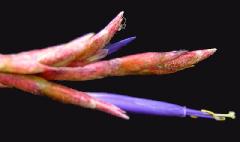
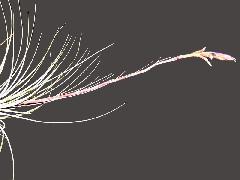
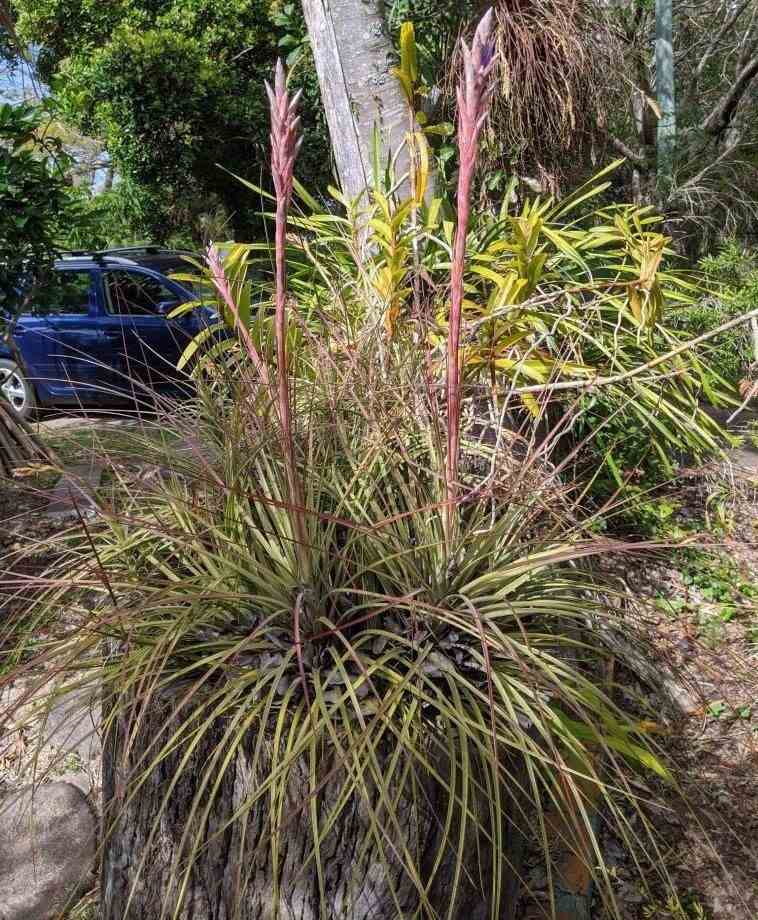

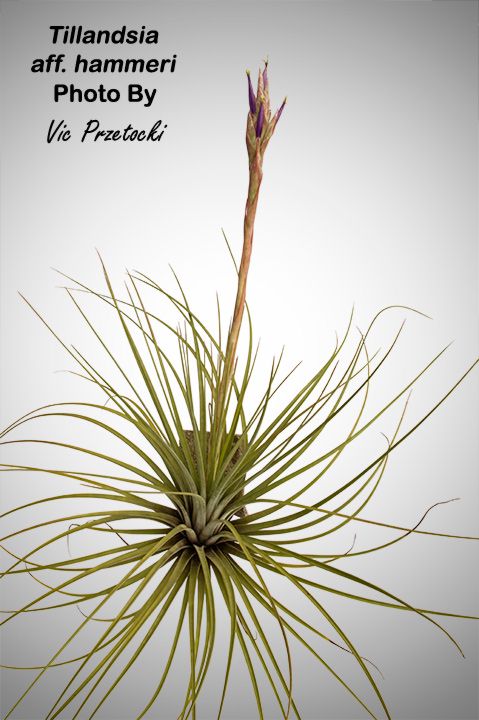

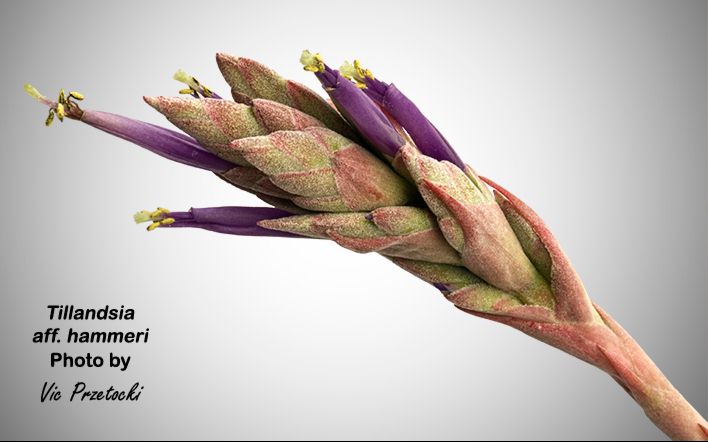
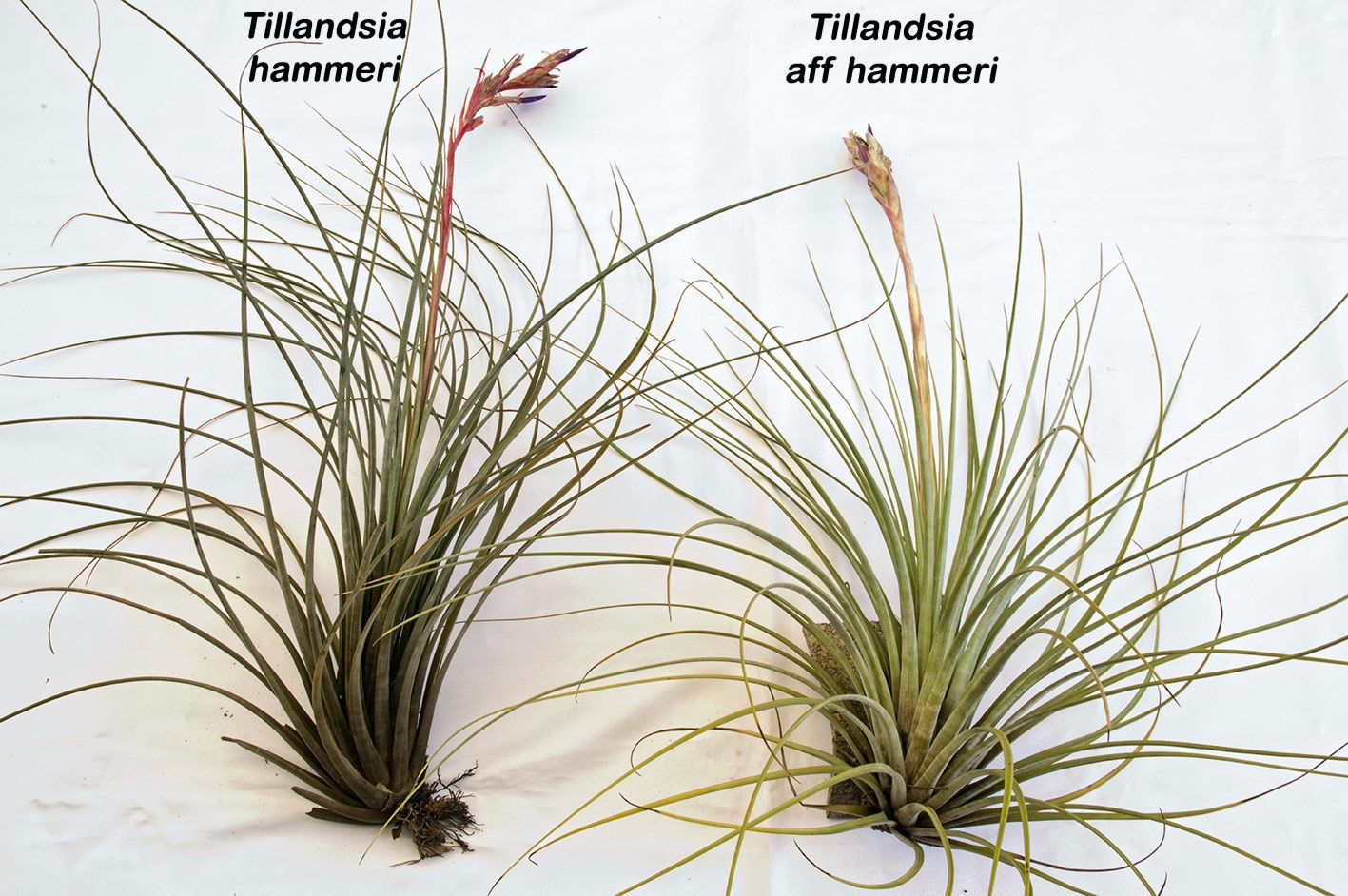
Tillandsia x floridana L B Smith pro sp. et stat. nov by Luther in Phytologia 57(3): 175. 1985
Plant - flowering to ca 0.6m high, usually much smaller
Leaves - numerous, densely cinereous, lepidote, stiff and erect.
Sheaths - triangular, to 2.5cm wide.
Blades - very narrowly triangular, to 0.8cm wide at midlength.
Scape - erect, shorter than to about equalling the leaves.
Inflorescence - densely digitate with 3 - 10 lateral, erect branches.
Primary Bracts - elliptic, densely lepidote, pink when alive.
Spikes - 5 to 13 flowered.
Floral bracts - densely imbricate, 2 - 2.5cm long, thin, nerved, variably lepidote, pink when alive.
Sepals - 1.7 - 2.2cm long, posteriorly connate and carinate
Corolla - to 4.5cm long, tubular, violet.
Stamens and Style - exserted.
Capsules - to 4cm long
Type - United States: Florida Osceola Co., 50 ft., 23 March 1953, MB Foster 2820 (Holotype: US)
Additional material examined: United States: Florida: Flagler Co., 18 April 1960, D. Ward 1851 (FLAS); Citrus Co., 1 June 1975, D. B. Ward 8837 (FLAS); Lake Co., 20 Aug. 19?, C. V. Nash 1704 (US, NY); Volusia Co., Aug. 1961, A. Laessle s.n. (FLAS); 7 July 1965, D. B. Ward 4770 (FLAS); Hernando Co., 20 May 1973, P. Genelle 129f (USF); Orange Co., date?, Miss Andrews s.n. (US); 22 June 1933, J H. Davis Jr. s.n. (FLAS); 16 Oct. 1948, R. W. Lewis s.n. (FLAS); 21 Apri11965, R. W. Read 1416a (US); 31 July 1976, R. P. Wunderlin 5644 (USF); Pasco Co., 7 March 1976, L. Baltzel 8142 (FLAS); Pinellas Co., 30 April 1970. P, Genelle 217 (USF); Hillsborough Co., 31 Aug. 1941, C. H. Beck s.n. (FLAS); 1 May 1961,G M Riegler s.n. (USF); 1963, W. Stook s.n. (USF); 7 Aug 1974, S. Todd 310 (USF ); 13 June 1979, L. Cobb 2 (SEL); Polk Co., 31 March 1880, J. Donnel Smith s.n (US); 23-30 Dec. 1925, O. E. Jennings s.n. (USF); 3 May 1961, C. R. Cooley 8300d (USF, NY); Osceola Co., 8 June 1960. D. B. Ward 2005 (US, FLAS); 30 December 1978, R. Wunderlin 6604 (USF); R. Wunderlin 6610 (USF) R. Wunderlin 6615 (USF); 15 Sept. 1979, H. E. Luther s.n. (SEL); Hardee Co., 5 Nov. 1966, D. B. Ward 6124 (FLAS); Desoto Co., 14 April 1961, BTY 421 (FLAS): Without specific locality: 24 Nov. 1979, P. Paroz s.n (SEL).
The narrow leaf Tillandsia taxa of central Florida have been a source of confusion for many years (Smith, 1966). Previous workers, dealing mainly with herbarium material have found great difficulty in applying names to the variable populations of tillandsias found from Lake Okeechobee northward in peninsular Florida. Only by observing living populations is it possible to understand this variation and correlate characters of the living plants with artifacts of preserved specimens.
In central Florida Tillandsia fasciculata Sw. var. densispica Mez (near the northern limit of its range) apparently hybridizes with the dominant species, Tillandsaia bartramii Elliot. Specimens more or less morphologically intermediate between these species are fairly frequent. In some populations the proported hybrid plants tend to greatly resemble the T. bartramii parent suggesting further backcrossing. It should be noted that the type specimen (Foster 2820 at US) more closely resembles a typical T. fasciculata var densispica than most of the additional material l examined. Mulford Foster (cf. letter with type at US) suggested a hybrid origin for his 2820 but appeared to dismiss this possibility without explanation. C. S Gardner (1982, and pers. comm.) also concluded that this taxon was of hybrid origin but did not propose any nomenclatural changes.
Tillandsia X floridana may be distinguished from T. bartramii by its larger size and more ample inflorescence as well as a tendency to form more erect, not hemispherical clusters. It differs from T. fasciculata by being usually somewhat smaller with narrower leaves and having pink (not red or green) rather thin, usually lepidote floral bracts.
Tillandsia Xfloridana by Derek Butcher 2000
In Flora Neotropica Monograph 14 Part 2 1977 Lyman Smith described Tillandsia floridana as a variety of Tillandsia fasciculata. It now seems firmly entrenched as a natural hybrid between Tillandsia fasciculata v. densispica and T. bartramii.
Toward the end of 1999 a plant I had received as Tillandsia setacea 10 years before again flowered and I felt sure it had to be the mysterious Tillandsia Xfloridana. I say mysterious because I had never seen a full description of this plant and there are very few photographs about. One I did find in the New Tillandsia Handbook by Hiroyuki Takasawa which I will refer to later.
I first put my queries to Dr Walter Till who kindly sent me a copy of Phytologia 57 (3) 1985 where Harry Luther had described this natural hybrid.
My problem was that this Tillandsia setacea had come from Arizona Cactus Nursery in Sydney, Australia in 1989 who had imported batches of tillandsias from Guatemala and California. It would have been unlikely to have come directly from Florida.
Let us look at the comments made by Harry Luther in 1985.
“The narrow leaf Tillandsia taxa of Central Florida have been a source of confusion for many years (Smith, 1966). Previous workers, dealing mainly with herbarium material have found great difficulty in applying names to the variable populations of tillandsias found from Lake Okeechobee northward in peninsular Florida. Only by observing living populations is it possible to understand this variation and correlate characters of the living plants with artefacts of preserved specimens.
In central Florida Tillandsia fasciculata v. densispica (near the northern limit of its range) apparently hybridizes with the dominant species, Tillandsia bartramii. Specimens more or less morphologically intermediate between these species are fairly frequent. In some populations the proported hybrid plants tend to greatly resemble the T. bartramii parent suggesting further backcrossing. It should be noted that the type specimen (Foster 2820 at US) more closely resembles a typical T. fasciculata v. densispica than most of the additional material examined. Mulford Foster (cf. letter with type at US) suggested a hybrid origin for his 2820 but appeared to dismiss this possibility without explanation. C. S. Gardner (1982, and pers. comm.) also concluded that this taxon was of hybrid origin but did not propose any nomenclatural changes.
Tillandsia Xfloridana may be distinguished from T. bartramii by its larger size and more ample inflorescence as well as a tendency to form more erect, not hemispherical clusters. It differs from T. fasciculata by being somewhat smaller with narrower leaves and having pink (not red or green) rather thin, usually lepidote floral bracts”
My plant fits into the description but could easily have come from Mexico where many like plants abound such as Tillandsia hammeri and T. juncea. To show what a tangled web we weave it may be noted that the “old T. juncea” of Florida is really T. bartramii! My plant could easily have been misnamed and remember that both T. fasciculata and T. bartramii occur in Mexico and could produce T. xfloridana-like hybrids there too!
My plea to the Floridian experts in home-grown tillandsias is for a photograph of a ‘normal’ T. Xfloridana to compare with mine. Please also look at the New Tillandsia Handbook page 105 where the plant seems closer to T. bartramii parent as advised in the Harry Luther statement.
Meanwhile I have decided not to link my plant with T. Xfloridana but to look towards T. hammeri.
282g. Tillandsia fasciculata var floridana L. B. Smith, Phytologia 15: 197. 1967.
Desc from S&D
Inflorescence of several small spikes like those of var densispica Mez of Florida. Floral bracts thin-coriaceous, somewhat lepidote.
TYPE. Foster 2820 (holotype US), on Taxodium, near Holopaw, 15 m alt, Osceola County, Florida, United States,23 Mar 1953.
DISTRIBUTION. Epiphytic, southern Florida
UNITED STATES. FLORIDA, Palm Beach: West Palm Beach, Bartsch s n (US): Monroe: Pine Crest, 18 Feb 1930, Moldenke 656 (NY, US).
Tillandsia hammeri Rauh et Ehlers, Trop. Subtrop. Pflanzenwelt 60: 67-9 1987
Plant - stemless, flowering 90 -100cm high.
Leaves - numerous, rigidly erect, forming a 50cm tall rosette with a 50cm diam..
Sheaths - more or less distinct, triangular, 2.5cm long, 1.5cm wide, both sides densely brown lepidote.
Blades - narrow-triangular-acute, canaliculate, to 40cm long, 5mm wide, somewhat succulent, both sides covered densely in grey-white trichomes, therefore appearing grey.
Scape - erect, about 60cm long, exceeding the leaves by far, round, 5mm diam., tightly enveloped by scape bracts.
Scape bracts - erect, densely imbricate, subfoliate, basal bracts with pale-crimson, lepidote sheath and elongated filiform, green, lepidote blade, apical ones with shorter, crimson blade.
Inflorescence - laxly bipinnate, about 20cm long, with 8 - 10 lateral spikes, basal ones laxly, apical ones more densely arranged.
Spikes - erect projecting, basal ones occasionally strongly spreading and rhachis therefore flexuous, about 5cm long, 1cm wide, complanate, 3 to 5 flowered.
Primary bracts - resembling apical scape bracts, basal ones longer, apical ones more or less as long as spikes.
Floral bracts - densely imbricate, elliptic, obtuse, 1.5cm long, 1cm wide, green, diffused with red, densely white lepidote, with hyaline margin, ecarinate, a little shorter than the sepals, probably nerved in dry state.
Flowers - sub-sessile, erect, about 5.8cm long.
Sepals - light green, more or less obtuse, membranous, 18mm long, smooth (nerved in dry state), posterior ones are carinate and connate to about 1cm.
Petals - lingulate, erect with recurved tips, violet, white towards base, 4.4cm long.
Stamens and Pistil - far exceeding petals. Filaments straight, white, broader towards apex and violet. Anthers blackish-violet containing yellow pollen. Pistil longer than Stamens, greenish-yellow.
Holotype - BGH 66719, leg. G. Hammer (March 1984), in Herb. Inst. System. Bot. Univ. Heidelberg (HEID)
Distribution - on rock cliffs between Oaxaca and Tehuacan, 2500m. near the habitat location of T. schatzlii Rauh
Differs from T. juncea in
1. Leaf blades narrow – triangular – acute, not linear- subulate and filiform- attenuate.
2. Inflorescence laxly bipinnate, not densely digitate.
3. Floral bracts shorter than sepals and ecarinate.
4. Sepals blunt, not acute.